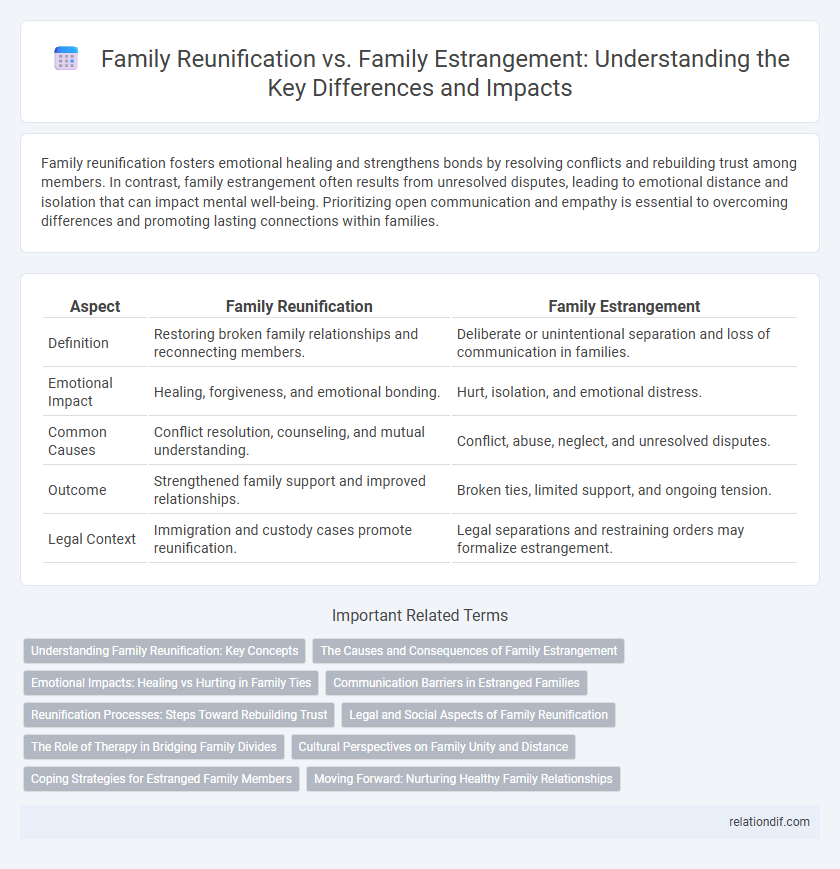Family reunification fosters emotional healing and strengthens bonds by resolving conflicts and rebuilding trust among members. In contrast, family estrangement often results from unresolved disputes, leading to emotional distance and isolation that can impact mental well-being. Prioritizing open communication and empathy is essential to overcoming differences and promoting lasting connections within families.
Table of Comparison
| Aspect | Family Reunification | Family Estrangement |
|---|---|---|
| Definition | Restoring broken family relationships and reconnecting members. | Deliberate or unintentional separation and loss of communication in families. |
| Emotional Impact | Healing, forgiveness, and emotional bonding. | Hurt, isolation, and emotional distress. |
| Common Causes | Conflict resolution, counseling, and mutual understanding. | Conflict, abuse, neglect, and unresolved disputes. |
| Outcome | Strengthened family support and improved relationships. | Broken ties, limited support, and ongoing tension. |
| Legal Context | Immigration and custody cases promote reunification. | Legal separations and restraining orders may formalize estrangement. |
Understanding Family Reunification: Key Concepts
Family reunification refers to the process of restoring relationships and reestablishing bonds between family members who have been separated due to conflict, migration, or estrangement. Key concepts include effective communication, forgiveness, and emotional healing, which facilitate rebuilding trust and fostering a supportive environment. Understanding these principles enhances the chances of successful reunification and long-term family cohesion.
The Causes and Consequences of Family Estrangement
Family estrangement often stems from unresolved conflicts, abuse, or differing values causing emotional distance among members. Consequences include psychological distress, social isolation, and weakened support networks, impacting overall well-being. Understanding root causes aids in addressing estrangement and promoting healthier family dynamics.
Emotional Impacts: Healing vs Hurting in Family Ties
Family reunification often fosters emotional healing by restoring trust, communication, and a sense of belonging, which are critical for individual well-being and collective resilience. In contrast, family estrangement can cause deep emotional pain, including feelings of abandonment, loneliness, and trauma, leading to long-term psychological challenges. Understanding these emotional impacts is essential for addressing conflicts and promoting healthy family dynamics that support mental health and emotional recovery.
Communication Barriers in Estranged Families
Communication barriers in estranged families often stem from unresolved conflicts, emotional wounds, and a lack of trust, leading to avoidance or misinterpretation of messages. These obstacles create a cycle of silence and misunderstanding, further deepening the rift between family members. Effective reconciliation requires addressing these barriers through open dialogue, empathy, and sometimes professional mediation to rebuild connections.
Reunification Processes: Steps Toward Rebuilding Trust
Reunification processes involve structured steps such as open communication, therapy sessions, and mutual acknowledgment of past grievances to rebuild trust between estranged family members. Consistent effort in empathy and willingness to forgive are critical for successful family reunification, helping to restore emotional bonds and create a supportive environment. Professional mediation and counseling often serve as essential tools in facilitating dialogue and resolving deep-rooted conflicts during these processes.
Legal and Social Aspects of Family Reunification
Legal aspects of family reunification involve navigating immigration laws, obtaining visas, and fulfilling residency requirements to enable separated family members to live together legally. Social aspects emphasize the restoration of familial bonds and emotional support networks that contribute to individual well-being and community cohesion. Policies facilitating family reunification aim to reduce social isolation and promote integration within host societies.
The Role of Therapy in Bridging Family Divides
Therapy plays a crucial role in bridging family divides by providing a safe, structured environment where family members can express emotions and rebuild trust. Evidence-based approaches like family systems therapy and narrative therapy help address underlying conflicts and improve communication patterns. These therapeutic interventions increase the likelihood of successful family reunification by fostering empathy, understanding, and long-term relational resilience.
Cultural Perspectives on Family Unity and Distance
Cultural perspectives on family unity and distance vary widely, influencing whether family reunification or estrangement occurs. In collectivist cultures such as those in East Asia and Latin America, strong emphasis on interdependence promotes family reunification and close-knit relationships, reinforcing shared responsibilities and emotional bonds. Conversely, individualistic societies like those in Western Europe and North America often prioritize personal autonomy, which can lead to greater acceptance of family estrangement as a means of maintaining personal well-being.
Coping Strategies for Estranged Family Members
Estranged family members often rely on coping strategies such as establishing boundaries, seeking therapy, and building supportive social networks to manage emotional pain and foster resilience. Developing mindfulness practices and engaging in self-reflection can also help individuals process complex feelings related to family estrangement. Prioritizing personal well-being and creating alternative chosen family connections serve as essential mechanisms for healing and growth during family separation.
Moving Forward: Nurturing Healthy Family Relationships
Moving forward, nurturing healthy family relationships requires intentional communication, empathy, and setting clear boundaries to heal from family estrangement. Prioritizing trust-building activities and seeking professional counseling can facilitate family reunification, allowing members to rebuild emotional connections. Emphasizing mutual respect and consistent support strengthens the foundation for long-term familial harmony and well-being.
Family reunification vs Family estrangement Infographic

 relationdif.com
relationdif.com